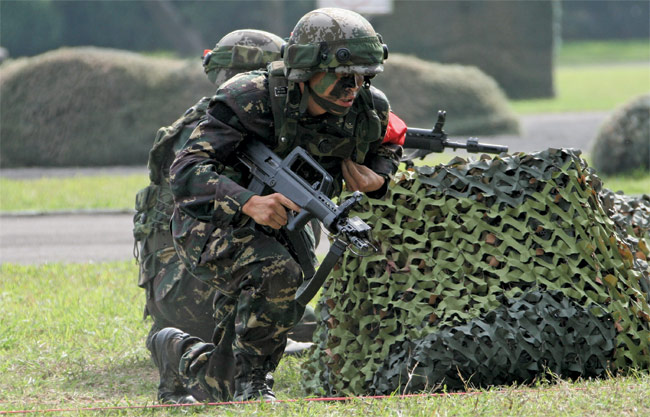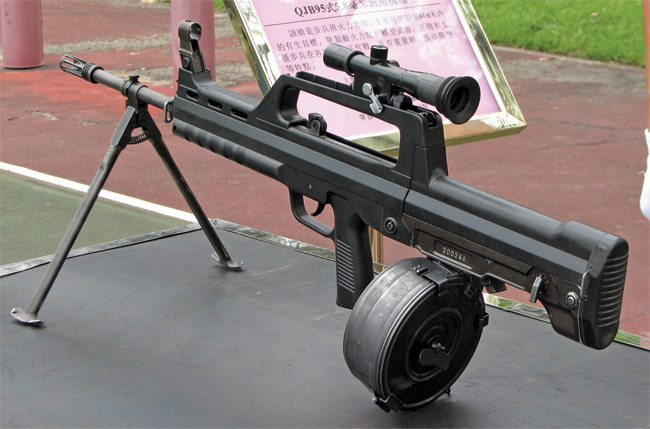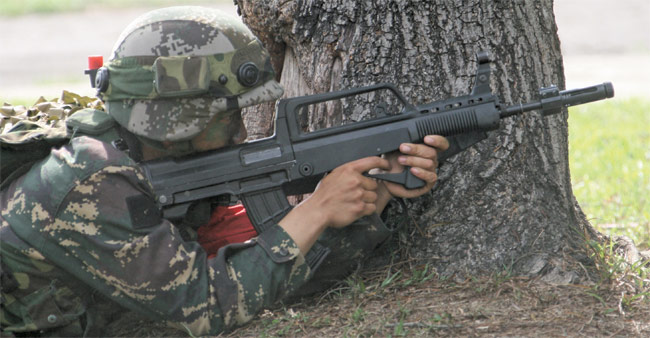The Hong Kong Special Administrative Region (HKSAR) returned to China’s bosom on 1 July 1997. As troops of the People’s Liberation Army (PLA) rode into the former British colony, it was clear that the sun had finally set on 156 years of British rule. One thing of interest on that day in 1997 was the fact that arriving Chinese troops were wielding a hitherto unseen type of weapon. Known as the QBZ95 (or Type 95) assault rifle, it marked a distinct break with convention for the Chinese military – it was a bullpup design and it introduced a brand new 5.8mm caliber. Indeed, the Hong Kong Garrison was the first unit to receive this new type of weapon, as befitting its position in the international limelight.
This same rifle remains in service with the Hong Kong Garrison of the PLA, a force that boasts carefully selected personnel of only the highest mettle and discipline. Interestingly, Chinese soldiers are rarely seen outside their barracks to ensure their image goes untarnished in the territory, and perhaps at the same time to prevent them from being ‘tarnished’ by Hong Kong’s more liberal philosophies than those espoused in communist China. This article examines the important Type 95 rifle in service with the PLA, utilizing information gained from the author’s long-time residence in Hong Kong.
It is unclear how large the Hong Kong Garrison is, with even the Hong Kong government confessing it does not know. However, the best estimates put the number of troops stationed in the territory somewhere between 4,000 and 5,000. It may not be a large garrison strategically for the PLA, but it does represent a politically symbolic force for the Chinese government. The Hong Kong Garrison is unique in that it integrates PLA, PLA Navy (PLAN) and PLA Air Force (PLAAF) contingents in one combined-arms battle group. The core of the PLA ground force is infantry battalions supported by helicopters and 6×6 armored vehicles.

Description
The Qing Buqiang Zu 95 (QBZ, literally ‘Light Rifle Family’) is a bullpup design with the action and magazine located behind the grip and trigger assembly. While a number of sources write weapon designations with a hyphen (e.g. QBZ-95), the PLA does not use a hyphen in its nomenclature and so this article follows this convention for the sake of accuracy. The QBZ95 is now the standard firearm of the PLA, and it is produced by Arsenal 266 of China North Industries Corporation (NORINCO) and Arsenal 296 of Jianshe Corporation, China South Industries Group Corporation (CSGC). It is also widely used by the People’s Armed Police (PAP) and other law enforcement agencies within the People’s Republic of China (PRC).
Development of the weapon began in the late 1980s, and by 1995 its design had received certification (hence its Type 95 designation). It followed on from NORINCO’s unsuccessful QBZ87 (Type 87) rifle. The Type 95 replaced the incumbent 7.62mm Type 81 assault rifle (an AK-47 copy), and at the time it represented a distinct departure from previous designs owing to its bullpup configuration. Its housing was manufactured from polymers, and it was designed specifically to fire the new Chinese-developed 5.8x42mm round known as the DBP87 that had been developed in the late 1980s. The small-caliber mild steel-cored bullet can be likened to the NATO 5.56x45mm SS109 and Russian 5.45x39mm cartridge, although China claims its cartridge is superior in terms of penetration, flatter trajectory and higher retained velocity. Nevertheless, it is important to recognize such assertions could emanate from Chinese rhetoric. In actual fact, for budgetary reasons, the DBP87 cartridge used cheap and corrosive powder, as well as lacquered steel casings, that affected performance. The DBP87 and updated DBP95 cartridge that weigh 4.26g have a muzzle velocity of 930m/s when fired from the Type 95 rifle.
By 2006, the Type 95 rifle had pretty much replaced the Type 81 in frontline units. Although the latter has continued in service in most PAP units and second-line PLA units, it is gradually being supplanted by its successor. A bayonet can be fitted and the QBZ95 can also launch rifle grenades from the muzzle using special blank ammunition. Another accessory is the 35mm QLG91B (Type 91B) under-barrel grenade launcher. Weighing 1.45kg and measuring 310mm in length, this breech-loading grenade launcher can fire both lethal and nonlethal rounds (tear gas, high explosive and illumination). It can thus be used to disperse crowds during anti-riot missions. A grenade’s muzzle velocity is officially listed as 75m/s.

Similar to other modern rifles, China’s QBZ95 operates with a short-stroke, gas-operated piston and rotating bolt. The rifle has an integrated carrying handle that incorporates the rear sight and mounting points for optical or night vision scopes. The standard open sight is graduated from 100-500m. Official data obtained from the PLA lists the weapon’s weight as 3.5kg and its length as 746mm. Its maximum effective range is 400m.
The selector switch is located, very inconveniently, at the left rear of the receiver behind the magazine housing. It has three settings: 0 (safe); 1 (semiautomatic); and 2 (fully automatic). It can still fire, even after complete immersion in water, as witnessed in televised tests. It is claimed the rifle is more controllable in automatic fire mode because of the small-caliber 5.8mm bullet and effective recoil buffer system. Because the Type 95 has not been directly observed in conflicts, it is difficult to draw overall conclusions about the weapon’s combat effectiveness.
The 30-round magazine inserts into the magazine well behind the pistol grip. It is inserted front first and then rocked into position in similar fashion to an AK-47. The magazine is released by pressing the magazine release rearwards and pivoting the magazine forward to disengage. The charging handle is positioned on top of the receiver under the integrated carrying handle. It is pulled fully to the rear and then released forward to chamber a round.

The bullpup design has proved somewhat controversial, with some infantrymen complaining it is not well suited to accurate shooting at distances longer than close-quarter battle (CQB) ranges. On the other hand, its shorter length and greater maneuverability are appreciated. In 2003, NORINCO revealed a new QBZ03 (Type 03) assault rifle of conventional design that also fires the 5.8mm DBP87 round. The QBZ03 appeared in the hands of airborne troops in the 60th Anniversary parade in Beijing in 2009, but it is unclear how widely it has proceeded into service with the PLA. Some have speculated that its introduction suggested the QBZ95 was not fully satisfactory in the eyes of the Chinese military. However, as the following section on the modified QBZ95-1 indicates, the PLA clearly plans to stick with the Type 95 design.
QBZ95-1 Modifications
After extended experience in the field, several issues with the QBZ95 needed addressing and these were rectified in the modified QBZ95-1 (sometimes wrongly referred to as the QBZ95 Gai or ‘G’; Gai translates as ‘Modified’). The QBZ95 had also drawn criticism for being rushed into production too quickly for political purposes in order to meet Hong Kong’s handover deadline in 1997.
Certainly, the new type is more reliable and easier to use thanks to improved ergonomics. For example, its greatest flaw was the safety switch awkwardly located far from the shooter’s hand, making it difficult to rapidly move from ‘safe’ to ‘fire’ modes. In the QBZ95-1, this selector switch has been repositioned above the pistol grip, allowing the operator to use his thumb to quickly transition to ‘fire.’

Another problem was that spent casings were expelled from an ejector port on the right side of the weapon, meaning the weapon could not be fired left-handed. No version existed with the ejector port on the left side. However, the new type moves the port forward by approximately 5mm and it now ejects casings at a 45º angle to allow, theoretically at least, left-handed firing. A bolt hold-open button is now found behind the magazine port too.
The first QBZ95-1 rifles were seen in early 2010 whilst undergoing trials. However, it took time for the modernized type to reach frontline units. Again, the first formation to publicly unveil the Type 95-1 was the Hong Kong Garrison, with these being first observed in July 2012 on the occasion of a military parade in honor of President Hu Jintao at Shek Kong Airbase in Hong Kong.
The QBZ95-1 is designed for the new 5.8x42mm DBP10 round. The DBP10 features non-corrosive primer, clean-burning propellant and copper-coated steel casings. The bullet body reportedly has a copper-alloy jacket and hardened steel core. The weapon has a longer and heavier barrel to give better accuracy and to cope with this heavier round, which will eventually become standard on all Chinese 5.8mm weapons. The rifle’s muzzle brake is also redesigned to compensate for the heavier round. The hand guard has a more diamond-shaped cross-section that better dissipates heat from the barrel.
As well as the aforementioned thumb-operated fire selector switch repositioned above the pistol grip, the QBZ95-1 can be quickly identified by the stronger butt stock and redesigned trigger guard. The front grip/trigger guard combination has been deleted, and this will allow custom front grips to be added in the future, plus installation of the 35mm quick-firing QLG10A grenade launcher, although the author has not yet seen this device in service.

The weapon retains a quick-release mount rail on the carrying handle, which has been lowered to allow more comfortable integration of scopes and sights. A pair of short rails at the base of the front sight allows soldiers to mount proprietary tactical accessories such as flashlights, laser sights and other accessories. The fluorescent illumination dots on the front sight have been replaced by a pair of long-lasting tritium illumination dots. As the new type is introduced, older QBZ95 weapons will be handed down to second-line and reserve troops within the PLA.
According to official information from the PLA, the QBZ95-1 weighs 3.3kg (100g less than its predecessor). It is 744mm long and its maximum effective range remains the same at 400m. As before, the new type is available as a whole family line, including the QBZ95B-1 Carbine and QJB95-1 Light Support Weapon. It is likely the QBZ95-1 will continue to evolve, with the most obvious next step being the addition of a common mounting system such as the Mil-Std 1913 Picatinny rail instead of the current proprietary Chinese mounting system.
Variants
There are three basic variants of the QBZ95. Specifically these are the standard assault rifle as already discussed above, plus a shortened Carbine and a Light Support Weapon.
QBZ95B Carbine
The QBZ95B Carbine is a slightly shorter and lighter version of the standard weapon. Because of the shorter barrel, neither a grenade launcher nor a bayonet can be fitted. It is suitable for naval personnel working in confined spaces aboard ships, as well as CQB by special operation forces. Its effective range is shorter because of the reduced barrel length, and the muzzle has a special funnel-shaped flash suppressor. To date, the author has not seen the Carbine in service in Hong Kong, not even in the hands of Special Forces.

QJB95 Light Support Weapon
This is used by a squad machine gunner and it comes equipped with a bipod. Thanks to a longer and heavier barrel, it is well suited to the fire support role with a maximum effective range of 600m. It has a faster firing rate and heavier cartridge that fits inside a drum magazine. Although some sources list the drum as holding 80 rounds, official PLA documentation seen by the author lists the capacity as 75 rounds. The QJB95 weighs 3.95kg and it is 840mm long.
QBZ97 Assault Rifle
The QBZ97 is specifically an export version of the standard QBZ95 in use with the PLA, and a mirror image of the PLA’s family is available. The only differences are that it has been re-chambered for 5.56mm NATO ammunition, and it possesses a deeper magazine well to accept STANAG magazines. The QBZ97A adds a three-round burst mode and a bolt hold-open device. In fact, this is the only family variant to have seen sales success outside China. It is used by Cambodia’s 911 Special Forces unit and by the Myanmar Army, for instance. Sri Lanka is believed to be another user. An export Carbine version is also available and this is called the QBZ97B. The Light Support Weapon variant is the QBB97.
Technical Data for QBZ95
Caliber: 5.8x42mm
Action: Gas-operated rotating bolt
Length: 746mm
Barrel length: 520mm
Weight (unloaded): 3.4kg
Maximum effective range: 400m
Rate of fire: 650 rounds per minute
Magazine capacity: 30 rounds







